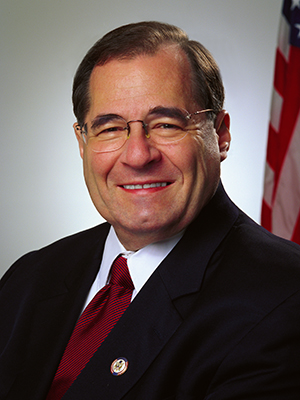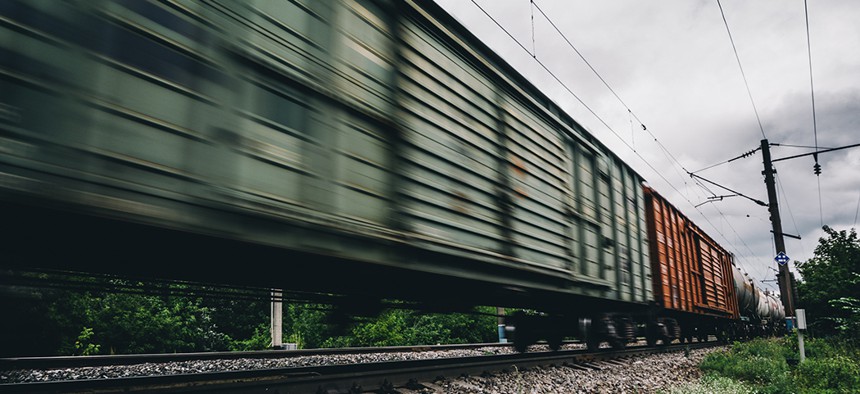For more than three decades, Rep. Jerrold Nadler has championed creating a freight rail line that would connect New Jersey and Brooklyn. While it’s an idea that has been discussed for the past century, the prospects of it happening are as good now as they’ve ever been, with the start of a Tier II environmental impact statement process by the Port Authority of New York and New Jersey and the de Blasio administration’s July announcement of a FreightNYC initiative.
It would likely take until at least the latter half of the 2020s until freight would be able to move under the harbor – and one of its most vocal champions says acting now would allow it to be built before economic growth in the region would be curtailed by a lack of transportation infrastructure.
In an interview with City & State, Nadler discussed why he thinks this program is so vital to the future of the region as well as the economic, environmental and national security benefits it would provide. This interview has been edited and shortened for clarity.
Where are we in the centurylong effort to make a cross-harbor freight line happen?
The second tier of the environmental impact statement is designed to do the engineering and work out the costs and work out the finances. Those are the three essentials and that should be done in 24 or 30 months or so – about 2021 to 2022 is when the EIS will be completed. You then have to have an approval process, which will take a year or two. Now the EIS would recommend financing mechanisms, but you would have to have those financing mechanisms approved. Depending on what they were, they could be easy or hard to get political consensus behind.
As the EIS progresses, we’ll be talking to a lot of – I mean to other elected officials – we’ll be talking to community groups, the Port Authority. A part of the EIS is a community outreach program so people can know something about it and there’ll be a community input process certainly also. And this will have to happen in both states by the way, New York and New Jersey.
Who are all the different players involved in getting this done?
The players would be the two governors, obviously, and the heads of the Port Authority who are appointed essentially by the two governors, the board of directors of the Port Authority, probably the mayor. I don’t know if he has a official role but he would certainly be involved in various ways, possibly various officials in New Jersey. Depending on the financing, maybe the state Legislature, maybe Congress.

If New York were still a forest and you wanted to say: ‘Let’s build a city from scratch. Let’s plan out the freight lines and the subway lines and everything,’ you might do it very differently than the way it is, but you have to fit it into existing things so, for example, you got the Bay Ridge Line. I always call that the aorta of New York rail freights because everything ultimately goes through it or has to go through it. The tunnel is essentially connecting the Bay Ridge Line to lines in New Jersey and the location of the tunnel is basically dictated by where the existing rail lines are.
What concerns do you see at the local level that could become fodder for the opposition?
First of all, you are going to have to have freight terminals, and one of the things that the EIS will recommend is the location and size of those terminals. One of the major ideas of the tunnel is to cut out truck freight, to greatly reduce the number of 18-wheelers going into New York City highways and highways near New York and New Jersey, and while it will do that, it can’t eliminate the last mile.
There could be concerns about increasing trucks at the locations of certain terminals. We’re going to have to deal with that and take remedial action to make sure you’re not overwhelming any community even though the truck numbers will be reduced generally. We’ll have to make sure that is part of the EIS.
There may be some demagogic politicians or others who try to scare a local neighborhood and hopefully the facts won’t justify those scares. Last time, we had people very concerned in Borough Park, (Brooklyn), that increasing the number of trains using the existing rail line would be very noisy and those fears have largely dissipated, but they could come back again. We’ll have to take actions that ensure that that won’t be the case.
What lessons are there from past infrastructure projects?
West Way was a project that was supported by Gov. Hugh Carey, Gov. Mario Cuomo, Mayor Ed Koch, the leadership of the legislature, every major politician, The New York Times. I mean everybody supported it – except a band of West Siders who opposed it and some environmentalists. And this was supposed to be on where the West Side Highway is from the Battery to 42nd Street.
It was supposed to be a buried eight-lane highway out at the pier head line offshore. And that would mean that all the land between what’s now the shore and the pier head line would be all developed. This fight went on from 1971, 1972, until the late ’80s when we finally defeated it.
The lessons were No. 1, be absolutely honest with the EIS. Don’t try to fudge it, because everytime they fudged the EIS, we got it knocked down and they had to do it over again.
Lesson No. 1 is to be honest about all the implications and describe them properly and deal with them. Don’t try to hide things and take into account the environmental impacts on the neighborhood on everybody else and make it upfront.
How do you see the city, state and federal governments working together on this – or not working together on this?
We’re going to need everyone to work together obviously and hopefully we will be past the Trump administration, which doesn’t want to work with anyone on infrastructure. But we’re going to need a cooperative city, state and federal administration. All you can really say at this point is who knows who’s going to be the mayor, the governor, the president five years from now, 10 years from now even.
The economics are so overwhelming that it’s something that’s got to be done. One of the things is if you’re looking at the current city projections, by 2040 or ’45, the amount of freight by volume coming into New York City and Long Island is going to increase by 68 percent. We can’t handle them physically on our highways. If you can’t handle the additional freight, it will put an upward lid on economic development, period.
Why does it have to be rail, not some other technology?
You can move goods into the city and Long Island in one of three ways: by truck, by rail or by boat. In the United States, 43 percent of intercity freight goes by rail. East of the Hudson, it’s less than 1 percent. Now rail, you can say it’s a 19th century technology, but it’s three times as energy efficient as truck freight. It’s much less polluting. We have the highest rates of asthma in the world in the South Bronx, mostly because of the trucks. And one rail car can take the load of three and a half tractor trailers.
There’s also a security argument, which nobody mentions by the way. Because of various access points that don’t allow 14-foot vehicles past them, 93 percent of everything that comes into New York City, Long Island, Westchester, comes over the George Washington Bridge – 93 percent. We have a three-day food supply. If anything happens to that bridge, we’ll starve, literally. You’ve got to have redundancy.

NEXT STORY: How to take New York City back to its maritime roots in 2018


